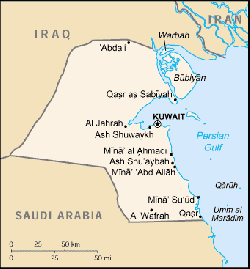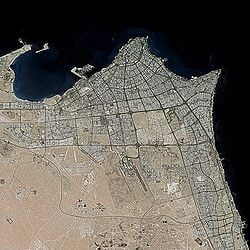Kuwait City
| Kuwait City مدينة الكويت Madinat Al Kuwayt |
|
| Kuwait City's skyline at night | |
| Coordinates: {{#invoke:Coordinates|coord}}{{#coordinates:29|22|11|N|47|58|42|E|region:KW_type:city | |
|---|---|
| name= }} | |
| Country | Kuwait |
| Governorate | Al Asimah |
| Area | |
| - Metro | 200 km² (77.2 sq mi) |
| Population (2005 estimate) | |
| - City | 32,500 |
| - Metro | 2,380,000 |
| Time zone | EAT (UTC+3) |
Kuwait City (Arabic: مدينة الكويت, transliteration: Madīnat al-Kūwait), is the capital and largest city of Kuwait. It has an estimated population of 63,600 (2006 estimate) [citation needed] within city limits and 2.38 million in the metropolitan area. Located at the heart of the country on the shore of the Persian Gulf, and containing Kuwait's parliament (Majlis Al-Umma), most governmental offices, the headquarters of most Kuwaiti corporations and banks, it is the indisputable political, cultural and economic center of the emirate.
Kuwait City’s trade and transportation needs are served by Kuwait International Airport, Mina Al-Shuwaik (Shuwaik Port) and Mina al-Ahmadi (Ahmadi Port) 50 kilometers to the south, on the Persian Gulf coast.
History
Kuwait City was first settled in the early 18th Century by the Al-Sabāh clan, later the ruling family of Kuwait and a branch of the Al-Utūb tribe (that also included the Al-Khalīfah clan, the ruling family of Bahrain), and their leader, Sheikh Sabāh I. Its name may have derived from an earlier abandoned fort located there, called "Kūt" (كوت) - Arabic for a fortress by the sea.
The settlement grew quickly, and by the time its first wall was built (1760), the town had its own dhow fleet of about 800 and trading relations to Baghdad and Damascus. It was a successful and thriving sea port by the early 19th Century.
It was unclear whether or not Kuwait was part of the Ottoman Empire, and as a result, tensions often broke out between the sheikhdom and the empire. These tensions peaked when, in 1896, Sheikh Mubārak Al-Sabāh assassinated his brother, the emir Muhammad Al-Sabāh, over Mubārak's deep suspicion that the Ottoman Empire was willing to annex Kuwait.
In exchange for British naval protection, Mubārak was not to negotiate or give territory to any other foreign power without British consent. With the discovery of oil in 1936, the city’s standard of living improved dramatically, including health and education services.
In August 2, 1990, Iraqi forces seized the city and on August 8 they annexed the emirate. During the occupation, the city was extensively damaged and many buildings were destroyed after it, including the Kuwait National Museum.
After Iraqi forces retreated from Kuwait in January-February 1991, foreign investors and the Kuwaiti government were actively involved in modernizing the city and turning it into a world-class business hub. Many hotels, shopping malls and offices were built in the city indicating the economic growth since the war.
Suburbs
Although the districts below are not usually recognized as suburbs, the following is a list of a few areas surrounding Kuwait city:
|
|
Economy
Kuwait’s booming economy has allowed many international hotel chains to enter agreements to open hotels in the country. According to the Kuwait Hotel Owners Association, over twenty-five new hotels are planned or in construction, including the following:
- Golden Tulip Kuwait - opening late 2008
- The Regent Messilah Beach Resort & Spa - opening late 2008
- Hotel Missoni Kuwait - opening Q1 2009 (the world's first Hotel Missoni)
- Hilton Olympia Kuwait - opening Q2 2009
- The Monarch Luxury Hotel & Conference Center - opening late 2009
- InterContinental Kuwait Downtown - opening early 2010
- The Square Capital Tower - opening late 2010
- Four Seasons Hotel Kuwait at The Gate of Kuwait - opening 2011
By 2010, over 3,000 rooms are expected to be added to Kuwait’s hotel inventory.
Sister Cities
The following is a list of Kuwait City's sister cities:
See also
- Madinat al-Hareer
External links
- (German) Kuwait City at "goruma"
| |||||||||||||||||

